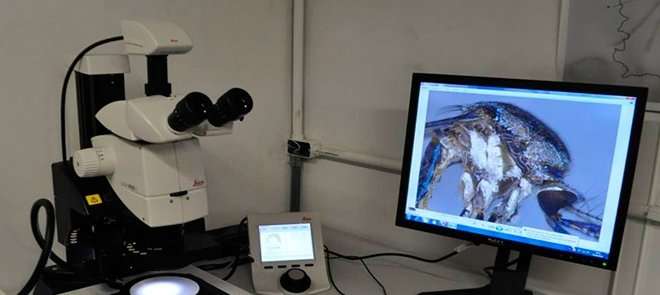Disease-bearing mosquitoes gain from shrinkage of green spaces

Urbanization and the resulting shrinkage of green spaces in cities are a boon for mosquitoes that transmit pathogens, including Aedes aegypti (dengue) and Culex quinquefasciatus (lymphatic filariasis). More adapted to urban areas, they benefit from the decline in populations of other mosquito species.
In Brazil's biggest city, São Paulo, researchers studied a collection of 37,972 specimens of the family Culicidae from nine municipal parks. Later laboratory analysis would show that these mosquitoes belonged to 73 species and 14 genera. Among the results published in Scientific Reports are the findings that the number of mosquito species is decreasing and that species that act as vectors of human pathogens have benefitted adaptively.
"The vector species have adapted to urban environments. As green areas are reduced, wild species gradually disappear, and urban-adapted species dominate the territory. They are the species that transmit the most pathogens," said co-author Antônio Ralph Medeiros-Sousa, a Ph.D. student at FSP-USP.
Five species accounted for 68 percent of the insects collected: Culex nigripalpus, Aedes albopictus, C. quinquefasciatus, A. fluviatilis and A. scapularis. Other vector species—C. declarator, A. aegypti, C. chidesteri, Limatus durhami and C. lygrus—were also found more frequently in the urban parks. Scientists also showed that vector species comprise the eight most-common species found in the research's general sampling.
According to Medeiros-Sousa, fragmentation and reduction of green areas benefit vector mosquitoes owing to extinction of wild species. "There's a correlation between the size of green spaces and species diversity. Smaller green areas tend to have a subset of the species found in larger green areas, and the range of species in smaller areas tends to comprise mainly vectors," he said.
Investigating the risk of epidemics
The study also shows significant differences between the parks in terms of species richness. Sixteen species were collected from Ibirapuera Park, which is 1.58 km², compared with 47 species from Anhanguera Park, which is 9.5 km². As expected, smaller green fragments are more susceptible to environmental disturbances, which mainly drive out the less-abundant insect species.
"Collecting almost 50 mosquito species in an urban park is impressive," Medeiros-Souza said. "We didn't expect such a large number. It was a surprise, even though we knew some areas, including Anhanguera Park, must have higher diversity because of their size."
Despite finding higher concentrations of vector mosquitoes, the researchers stress that this does not necessarily entail a higher risk of transmission, only a greater likelihood of contact between vector mosquitoes and humans.
"It doesn't mean there will be more disease. The other factor that determines the incidence of disease is the presence of pathogens, such as dengue, Zika or yellow fever virus. The study shows that there's an imbalance, with less species diversity in smaller and less conserved areas," said co-author Mauro Marrelli, associate professor at FSP-USP and Medeiros-Sousa's Ph.D. supervisor.
According to the authors, the data analyzed in the study highlight the need for further research to better understand how habitat loss and fragmentation due to urbanization affect vector insects and influence the risk of pathogen transmission.
Green islands
The correlation between area and diversity is explained by the equilibrium theory of island biogeography, which U.S. ecologists Robert MacArthur and Edward O. Wilson formulated in the 1960s. According to this theory, species richness on islands represents a dynamic equilibrium between immigration and extinction rates, which are affected by the island's size and degree of isolation. This theory can be applied to urban green spaces, since these form island-like habitats isolated by built-up areas.
In the case of mosquitoes, which do not live long or travel far, extinction has an even greater impact on species equilibrium. "We show that the theory of island biogeography applies to the city of São Paulo," Marrelli said. "We also note that smaller green areas tend to have greater similarity of species, since species that have adapted best to the urban environment tend to be selected. Almost 70 percent of the mosquitoes collected in our study belonged to only five species. That really is a problem."
Mosquitoes are a highly diverse group, with more than 3,500 known species. Studies of mosquito diversity in urban green spaces are therefore useful both to elucidate processes that lead to patterns of diversity in urban ecosystems and to understand the role of biodiversity in reducing or increasing the risk of pathogen transmission.
More information: Antônio Ralph Medeiros-Sousa et al, Mosquitoes in urban green spaces: using an island biogeographic approach to identify drivers of species richness and composition, Scientific Reports (2017). DOI: 10.1038/s41598-017-18208-x
Journal information: Scientific Reports
Provided by FAPESP




















